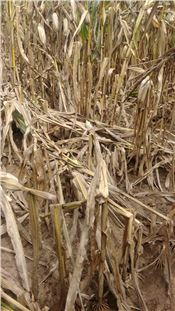Potential For Lodged Corn In 2022

Figure 1. Lodged corn
Photo: Kiersten Wise, UK
DR. KIERSTEN WISE
PRINCETON, KENTUCKY
Scouting reports across Kentucky have indicated that farmers need to be aware of potential lodging issues as corn harvest gets underway.
Pockets of fields scouted across the state show pre-harvest lodging and/or stalk strength tests have indicated a high potential for lodging to occur (Figure 1). It is important to identify fields that may have stalk rot issues or lodging potential to ensure timely harvest and minimize the impact of downed corn.
Potential Causes
While stalk rot diseases can cause lodging, abiotic factors such as drought stress, nutrient deficiencies, and other stresses experienced in 2022 have greatly contributed to this year’s lodging issues.
Drought stress can cause the plant to divert carbohydrates from the lower stalk tissue up to the corn ear to finish grain fill, which in turn weakens the stalk. Secondary organisms can colonize weakened stalks giving the appearance of a disease problem even when abiotic factors are the primary cause of the weakened stalks.
Scouting Fields for Possible Lodging Concerns Determine if lodging is a concern by scouting fields prior to harvest.
Drought-prone areas of fields or fields that experienced drought and heat stress will often exhibit lodging earlier than areas with heavier soils that hold moisture. Within these areas and across a field, consider using a lodging severity test, such as the push test, to measure the degree of lodging concern. To conduct the push test, use your arm to push the corn stalk 30-degrees from vertical at face level, using moderate pressure. If the stalk does not return to upright after the push, it is considered lodged, and has failed the push test. If 10 out of 100 stalks tested in a field fail the push test (10 percent), consider prioritizing the field for harvest to prevent lodging and yield loss. Late-season storms or high winds can exacerbate lodging issues in fields with weak stalks, and timely harvest can prevent additional damage from occurring.
Preventative Management
Stalk rots and lodging can be preventatively managed by planting hybrids resistant to stalk and foliar diseases, using crop rotation, ensuring adequate soil fertility, minimizing in-season stresses, and harvesting corn as soon as it is feasible. ∆
DR. KIERSTEN WISE: Plant Pathology Extension Specialist, University of Kentucky